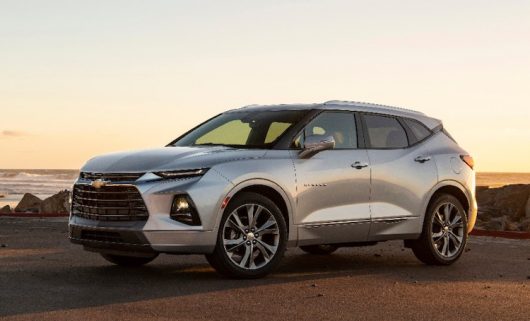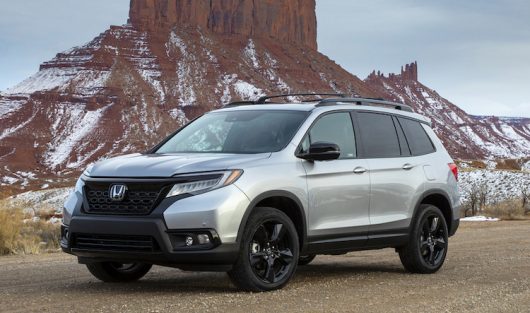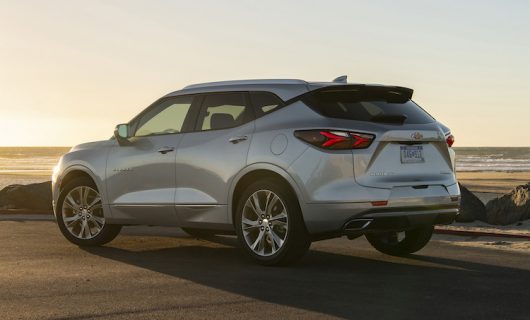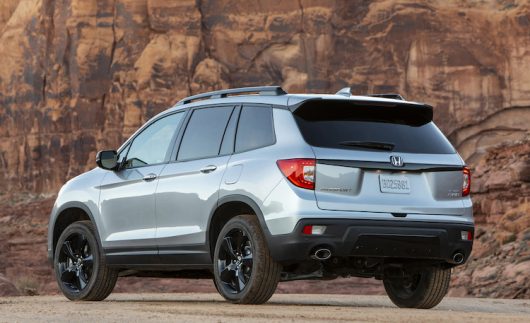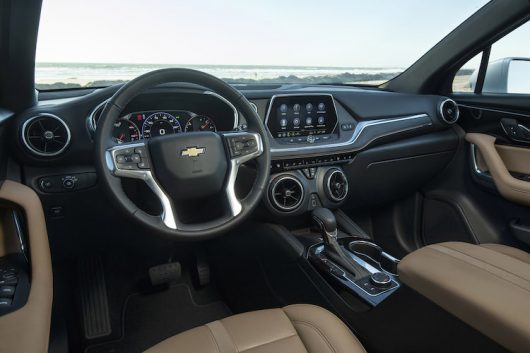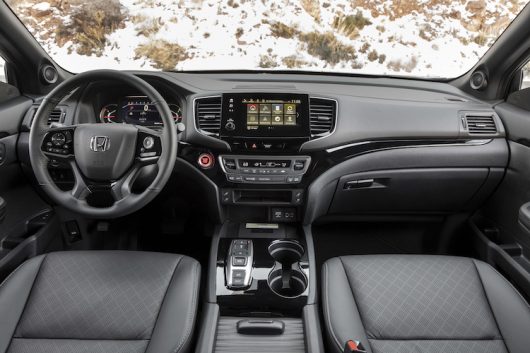Blazer v Passport – Who Wins?
Price May Be the Deciding Factor Between These Two Similar XSUVs- July 22, 2019
- Chevrolet, Honda
- Posted by George Peterson
- Comments Off on Blazer v Passport – Who Wins?
I’ve been itching to do a side-by-side of the Chevrolet Blazer and Honda Passport. The new crossover SUVs (XSUV) are similar, but not. Who wins the Blazer v Passport comparo? Follow along in reviewing the 2019 Chevrolet Blazer Premier v the 2019 Honda Passport Elite.
Dimensions: The Blazer and Passport are within inches of each other with the exception of height. The Passport has more ground clearance because Honda is touting its off-road chops. The Passport “can height” the dimension from the floor to the roof is also greater than Blazer. So, Passport is taller overall. Blazer v Passport – Tie
Exterior Styling: Blazer is definitely the more sporty looking of the two. It has a high beltline and relatively low roof. This gives it Camaro-esque window openings. Blazer’s faster windshield than the Passport gives it a sleeker appearance. Blazer’s front-end style has high slit-shaped accent lamps. This was tried by the Jeep Cherokee (later changed to a more conventional look) and the Hyundai Kona. Blazer pulls it off pretty well. Blazer’s grille is a sea of black and very aggressive. Blazer has a bodyside character line that sweeps up through the rear quarter panel.
Passport, a derivative of the Honda Pilot 8-Passenger XSUV, has a unique front-end style dominated by a gloss black grille and fascia. The Passport rear end cuts about ten inches off the Pilot’s overall length and adds a faster, sloping liftgate topped with a spoiler. The Passport looks more bulbous than the Blazer. Blazer v Passport – Blazer Wins
Interior Color Selection: The Blazer Premier is available with a black and maple trim set. The door armrests, door panel inserts and console box top match the maple color of the seat. The Passport Elite with a gray interior simply drops gray leather seats into the black interior. Clearly the seats are shared with the Honda Pilot, Ridgeline pickup and probably the Odyssey minivan. The lack of contrasting color armrests and door panel inserts gives the Passport a drab look. Blazer v Passport – Blazer Wins
Console Design and Center Arm Rest: The Blazer Premier has a console box with a cover that doubles as a center arm rest. The Honda Passport has a console box with flat cover that slides rearward. The flat cover is handy for dropping small “stuff” you might not have a place for otherwise. The center armrests on the Passport fold down from the sides of each front seat. They are adjustable for slope. The arm rest inevitably interferes with latching the seatbelt. These arm rests are appropriate for a minivan (where walkthrough is important) but not an SUV. Blazer v Passport – Blazer Wins
Getting In and Out: With its lower step-in height it is easier to slide into the Blazer than climb into the Passport. Blazer v Passport – Blazer Wins
Visibility: Blazer’s fast windshield and side window styling makes the Blazer more difficult to see out of. Visibility has usually been a forte of Honda products and Passport has good visibility from the driver’s seat all around the vehicle. Blazer v Passport – Passport Wins
Instrument Panel and Center Stack: The Blazer instrument panel design has a standup 8-inch center screen that is de rigeur these days. The instrument cluster is relatively conventional with three dials. The center dial is the speedometer. Under the center screen are a row of buttons for the heating and air conditioning system that are difficult to read. The Passport instrument panel is very ergonomic. The eight-inch center screen is bright and easy to read. The heater and air conditioning controls beneath the center screen are easy to see and understand. The Passport’s instrument cluster is dominated by a digital speedometer. A message display is beneath the speedometer. The tach is a horizontal bar running across the top of the cluster. Blazer v Passport – Passport Wins
Performance, Ride and Handling: Blazer is powered by a 308-horsepower 3.6L V6 engine mated to a 9-speed automatic transmission. Blazer is tuned for around town driving. Its ride is crisp. Handling is precise. Passport is powered by a 280-horsepower V6 engine with a 9-speed automatic transmission. Passport is tuned for outdoors and occasional off-roading. Passport’s ride is a bit stiff. Cornering is not as precise as Blazer’s due to a higher center of gravity. Blazer v Passport – Blazer Wins
Driveability: With very similar descriptions of the components, driveability in the Blazer is superior to the Passport. Its V6/transmission combination provides spritely acceleration and precise shifts. Passport’s V6/transmission combination lags with starting from a stop. Passport shifts abruptly when you aren’t expecting it. Blazer v. Passport – Blazer Wins.
Safety Features: When you option up the Blazer, you get adaptive cruise control, lane watch sensors, forward collision warning, etc. On Passport, the HondaSensing suite of safety features is standard even on the base model. Neither has adaptive cruise control with a stop/go feature. Frustrating. Blazer v Passport – Passport Wins
Surprises and Delights: Blazer is available with a cargo area management system. Passport has a standard covered compartment aft of the spare wheel. It is deep enough to carry groceries or plants from the nursery. Next to the spare tire, Passport has additional cubbies for storage of small items. Blazer v Passport – Passport Wins
Value: When you check all the boxes on the Blazer you can option the vehicle up to $52,000. Of course, even with a new vehicle there are incentives available, so they quickly offer a Blazer Premier for $49,000 on their website. The Passport Elite essentially has no options. There are tons of dealer-installed accessories available. When you select the top Passport, the price is about $44,000. Blazer v Passport – Passport Wins
Conclusion: Blazer may be the more compelling product around town with its swoopy styling and fun to drive dynamics. Passport is more sedate while still trying to be exciting from a styling standpoint. Passport is more practical. It is a Honda, after all. It does seem that Honda phoned-it-in by not having contrasting door trim panels. Probably a cost and complexity thing. Passport is tuned more for outdoor activities than the Blazer. So, what do you want? Do you want a city slicker that costs substantially more? Or do you want a practical vehicle at a lower price? You choose.
P.S. Given that the Honda Passport and Pilot have identical front two rows of seating, Honda could have used some Pilot trim pieces in the Passport. Case in point, the Pilot has contrasting lower instrument panel material and door trim panel material when you get the Elite trim level, The Passport gray seats swim in a sea of black. Not good.
